
|
 
|

|
Floral Postcards
Some antique postcards with a
floral theme. Use them for English language practice or just enjoy the
pretty images.
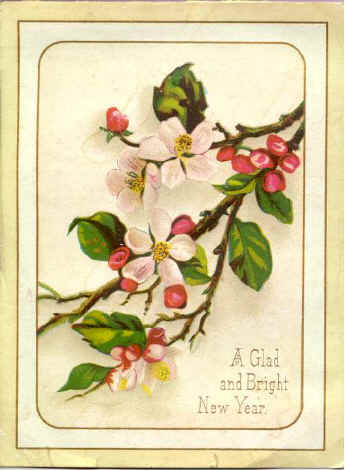 |
|
New Year Greetings Card, undated.
This is Apple Blossom.
Apples grow abundantly in many
areas of Britain, particularly in the south-western counties of England
and in Kent. These counties are famous for their apples and the cider
drink they produce from them. Many
people have one or two apples trees in their gardens and in the past
every large country house would have a small orchard of these trees
nearby. Consequently in British cookery there are many delicious recipes
for dishes using apples.
|
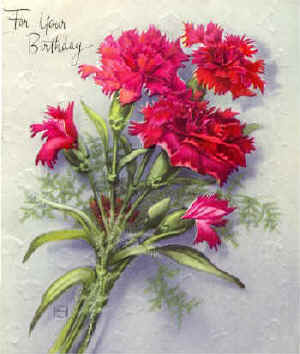 |
|
The carnation is one of our most
popular cut flowers. They are frequently included in bouquets and
bunches of them can often be bought cheaply at local shops and
supermarkets, in a variety of attractive shades.
As a garden flower they have been
grown in Britain for many centuries. Shakespeare even mentions them,
calling them the 'fairest flowers of the season'.
Often seen in gardens is the
smaller variety of this flower, which we call 'pinks'. They have the
most beautiful scent.
|
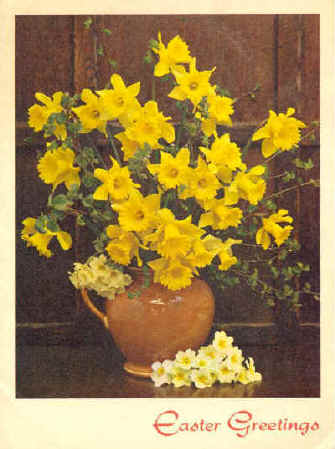
|
|
Bright yellow daffodils are
welcomed by everyone as one of the first signs of spring after the dark
days of the British winter. Here they are accompanied by pale primroses.
Daffodils grow wild in woodlands
and meadows throughout Britain. Many people grow them in their gardens
and local councils often plant daffodil bulbs on roadside verges to give
a splash of spring colour in town.
The flower is used as a symbol of
Wales and is often worn as a buttonhole on the National Day of Wales, St
David's Day, on March 1st.
|
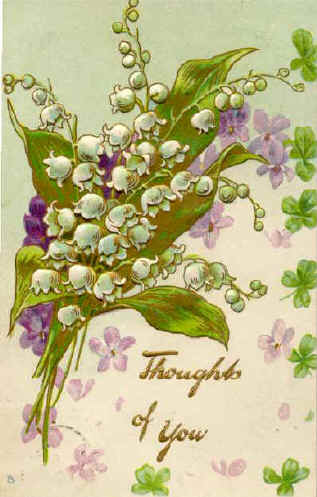
|
|
This old card was undated.
The lily of the valley is a
charming little flower that often appears in Victorian illustrations. It
thrives in shady situations and is much prized for it's lovely scent.
It is sometimes called the 'May
Lily' after the month when it flowers.
Here it is pictured with some
violets, which flower at the same time of year.
|
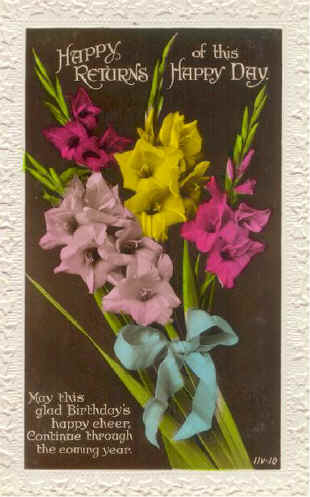
|
|
These brightly-coloured flowers
are gladioli.
A few years ago these tall blooms
were often seen at the back of flower borders providing some spectacular
summer colour for the beds.
It seems to me that recently fewer
people seem to go to the trouble of growing them.
They do have to be staked and tied
to stop them being damaged in the wind and perhaps this puts people off.
However enthusiasts still do love to grow them
and if you visit a local flower show you often see vases full of these
wonderful blooms.
|
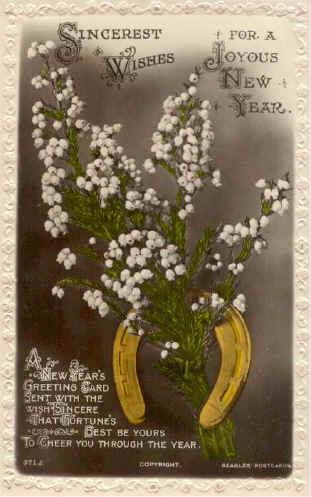
|
|
Heather is considered a very lucky
plant. Here it is shown with a horseshoe, which is also considered a
symbol of good luck, so the wishes here are obviously for a very lucky
year ahead. You can often
see a horseshoe nailed up above the front door of a house to bring good
luck to the occupiers. Some people hang it pointing down (like this one)
to let any bad luck fall out but others hang it the other way up to keep
the good luck in. I don't know which is correct!
This New Year card was never
posted and is undated.
|
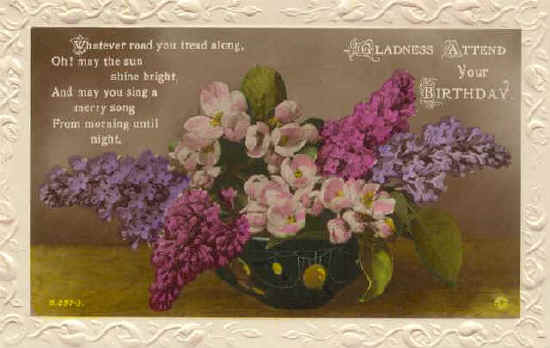 |
|
This photograph of blossom and
lilac has been coloured by hand. We do have lilac of two different
shades (white and pale purple) in our gardens but not exactly in these
strong colours. In fact we use the word 'lilac' to describe the pale
purple colour of these flowers. Some
people say that it is unlucky to cut the flowers and bring them indoors.
That's a shame because the scent is so lovely. The card was never sent and
is undated.
|
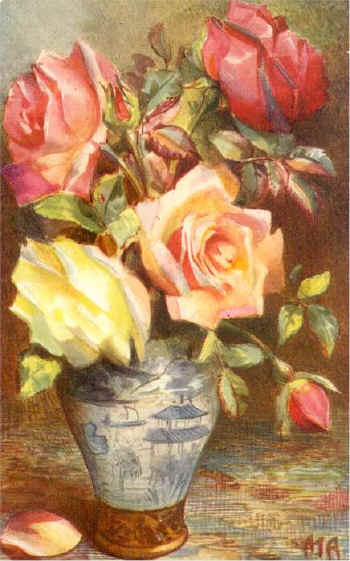
|
|
Everyone loves Roses! In summer
there is hardly a garden in Britain that does not contain at least one
or two rose bushes in bloom. Although they originated in China,
the mild winters and cool, damp summers that we have in Britain really
seem to suit them.
I can't resist roses myself, so
you can expect to find lots of pictures of them on this site in the
future!
This painted card was posted in
1917.
|
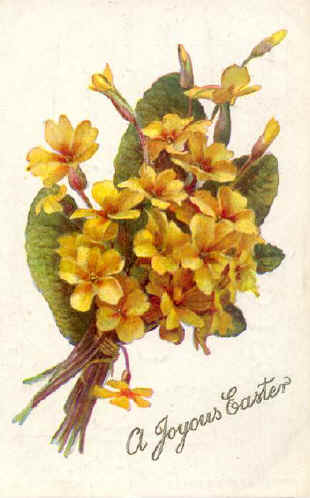
|
|
The primrose is a native plant of
Britain that can be found growing wild in our woodlands in spring. As
they were becoming scarce they are now protected by legislation so that
it is illegal to pick the flowers or dig up the plants for your own
garden!
Many cultivated varieties are now
available and can often be seen in window boxes and gardens early in the
year.
This Easter card was posted to
Bognor, on the south coast of England, in 1919.
|
|
|
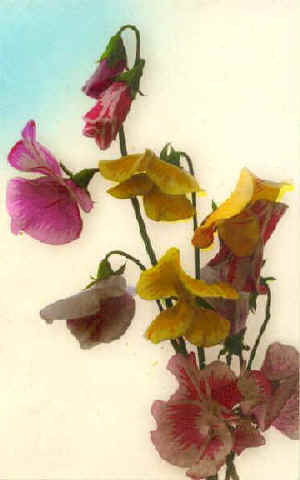
|
|
The delightfully scented sweet pea
has been a favourite with gardeners for many years. It is often grown
near houses so that the scent can be appreciated at every opportunity.
To encourage new flowers to bloom
it is necessary to keep removing the existing flowers. This is not a
hardship as they make charming cut flowers for the house.
This card was posted in 1927
to Farnham in Surrey.
|
|
|
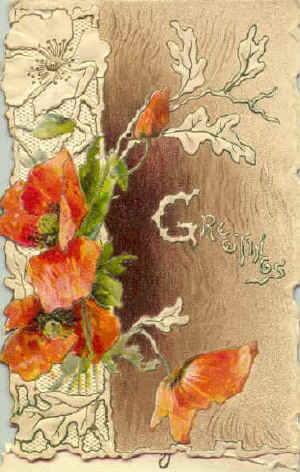
|
|
Bright red poppies like these are
a lovely sight to see in the summer fields and gardens of Britain. This
ancient plant has always grown in our cornfields alongside the crops. In
recent years chemical weed killer sprayed in the fields has prevented
their growth, so that they have only been seen in gardens and on
roadside verges.
This year, however, I saw quite a
few fields containing poppies so perhaps organic farming methods are
enabling them to return.
This greetings card is undated.
|
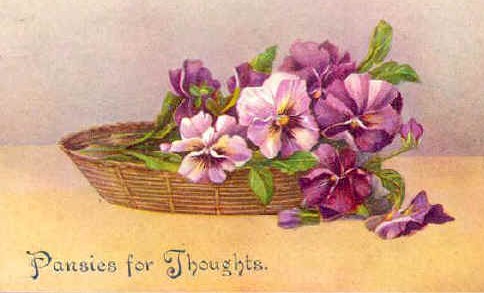 |
|
The colour of these pansies is
really gorgeous. The
Victorians wrote books on the 'language of flowers', attributing a
virtue or emotion to every flower. Pansies were said to look like people
standing with their heads lowered in thought and the French word for
'thought' is 'pensee' so the name probably derives from that word. If
you sent someone a bunch of pansies you were therefore 'thinking of
them'. This card was posted
in 1935.
|
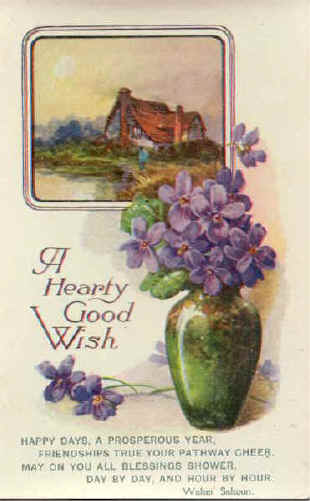 |
|
A charming old cottage and a vase
full of violets. What could be prettier. Violets
have been cultivated for their beauty and lovely scent for many
centuries. In Medieval times it was fashionable to grow decorative lawns
containing wild flowers such as violets. The
scent of the flower has been used for perfumes, soaps, jams, sweets,
chocolates and drinks. It is even possible to crystallize the flowers
with sugar and to use them as decorations for cakes.
This card was never posted and is
undated.
|
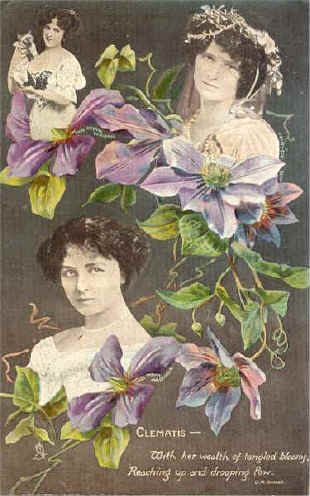 |
|
This attractive climbing plant is
a Clematis. They are often seen growing in combination with climbing
roses. The colours of the two flowers really complement each other.
In the country this plant was
often called 'old man's beard'.
This is because the seeds look
quite hairy. It is said that field mice make the insides of their nests
cosy by lining them with these fibres.
I don't know whether this lady
would look so calm if she knew there might be mice about!
This card was posted in 1907 to a
friend in Pontypridd, Wales.
|
|
| meadow
|
A field that contains grass and sometimes wild
flowers, often used for grazing cattle.
|
|
| a splash of colour
|
A colloquial expression used
to describe an element of colour in an otherwise dull situation. It is
as if an artist has taken some paint and thrown it there - just splashed
it on.
|
|
| buttonhole
|
This is the hole in a jacket or shirt that you
thread the button through. The word is also used to describe a flower
that is placed in the top buttonhole of a jacket as decoration, for
instance at a wedding.
|
|
| puts people off
|
This casual phrase is often used
to indicates a factor that dissuades people from something.
'The cold weather puts people off
going jogging.' |
|
|
|
|
|

|
|

|
|
